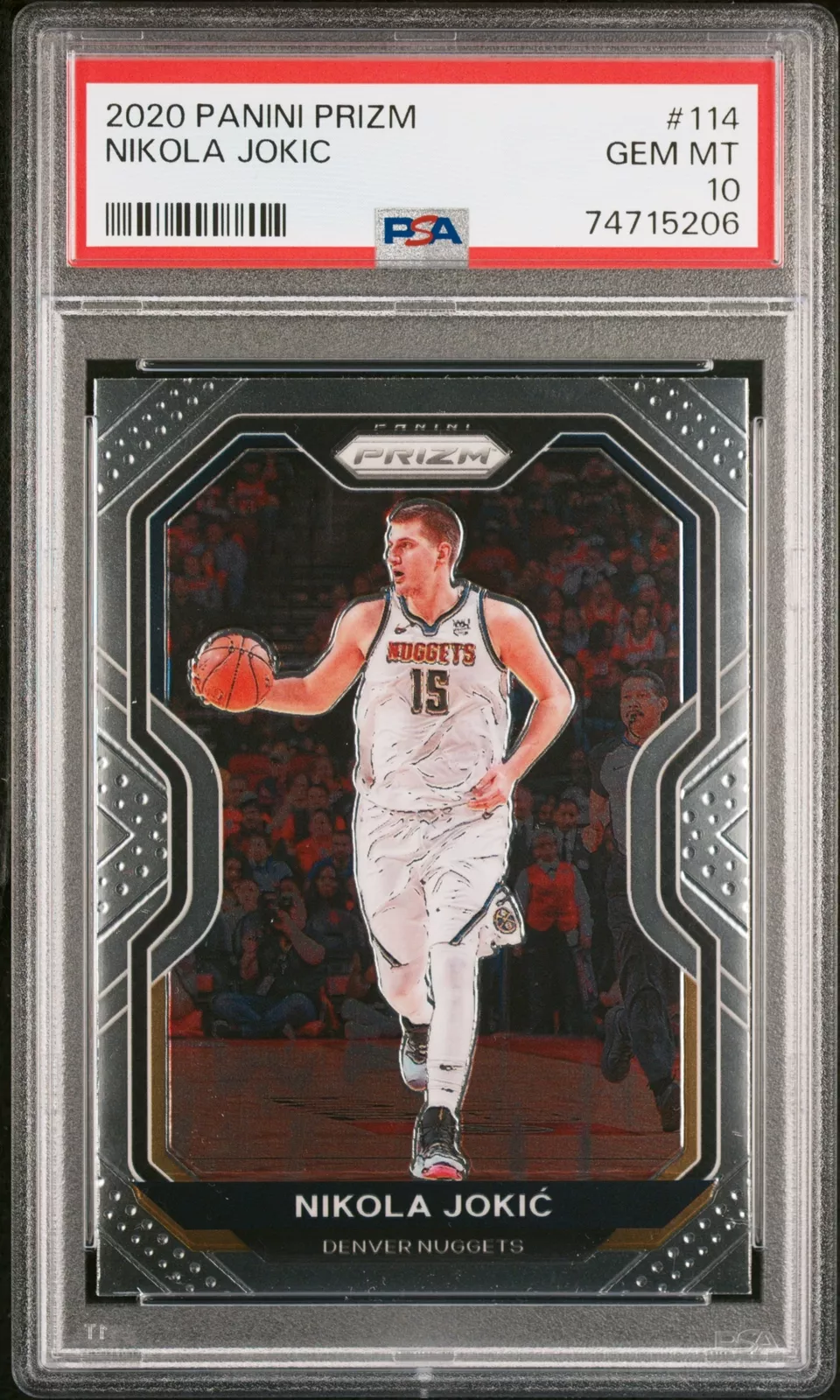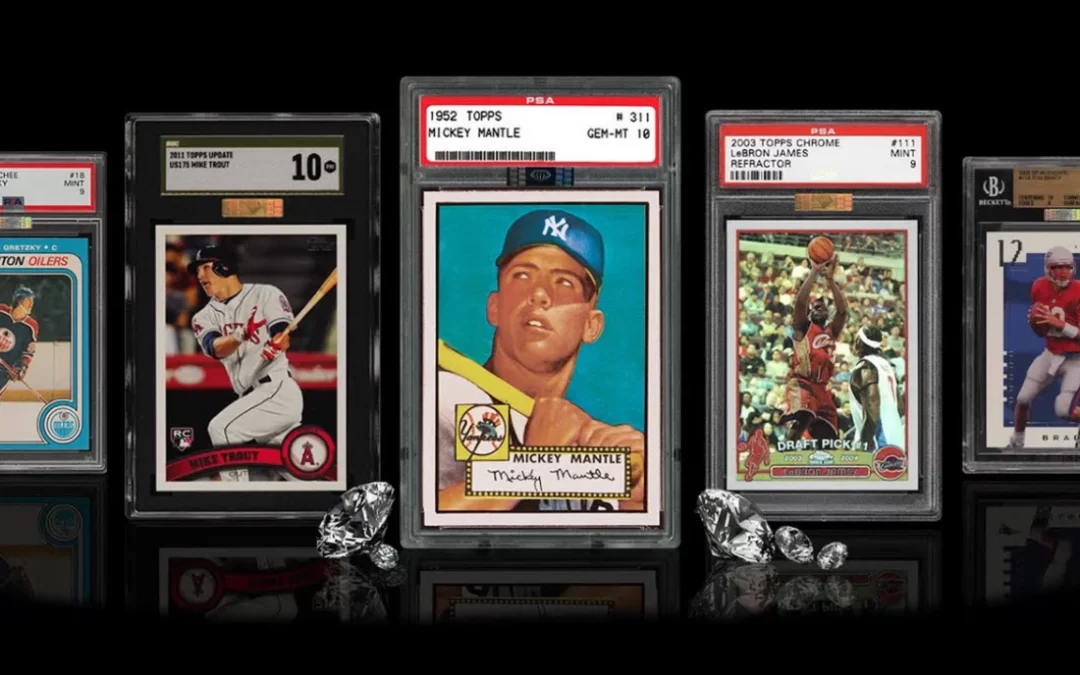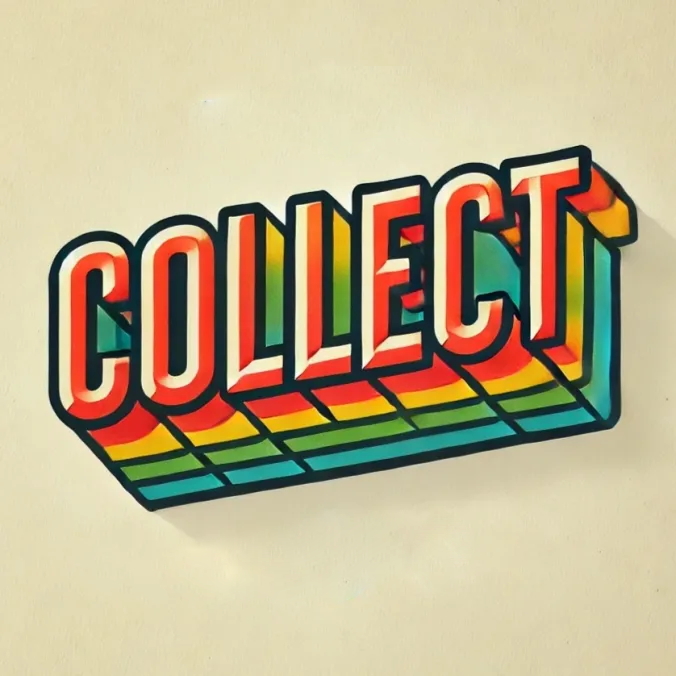For over 20 years, I’ve had the privilege of working with PSA, the world’s leading third-party trading card authentication and grading company.
One of the most common questions I encounter is, “What does PSA look for when grading cards?”.
Whether you’re a novice collector or an experienced trader, understanding the intricacies of PSA’s grading process can help you pre-assess your cards before sending them in.
This guide will provide you with the insights and techniques to evaluate your cards effectively, potentially saving you time and money while maximizing your cards’ value.
Understanding the PSA Grading Scale
The PSA grading scale is a comprehensive system used to evaluate the condition of trading cards, ranging from 1 to 10, with 10 being the highest grade. Each grade represents a specific level of quality and preservation, and understanding these distinctions is crucial for collectors aiming to maximize the value and appeal of their cards. Here’s a detailed breakdown of the PSA grading scale:
PSA 10 (Gem Mint)
- Description: A virtually perfect card. This grade is reserved for cards with four sharp corners, sharp focus, and full original gloss. The card should be free from any staining, but a slight printing imperfection is permissible if it doesn’t affect the card’s overall aesthetic appeal. Centering must be 55/45 to 60/40 or better on the front and 75/25 or better on the reverse.
- Example: A freshly pulled card from a pack with no visible flaws.
PSA 9 (Mint)
- Description: A card in mint condition may show one minor flaw, such as a slight wax stain on the reverse, a minor printing imperfection, or slightly off-white borders. The centering requirements are the same as PSA 10.
- Example: A card that appears perfect at first glance but has a tiny imperfection upon closer inspection.
PSA 8 (Near Mint-Mint)
- Description: Cards in this grade may have minor wear on the corners and edges and/or slight print imperfections. Centering must be 60/40 or better on the front and 80/20 or better on the reverse.
- Example: A card with slight corner wear and possibly a minor print spot or two.
PSA 7 (Near Mint)
- Description: This grade allows for minor corner wear, minor surface wear, and a few print imperfections. The centering must be 65/35 or better on the front and 90/10 or better on the reverse.
- Example: A card with noticeable but not severe wear that still presents well overall.
PSA 6 (Excellent-Mint)
- Description: Cards in this category may have visible wear on multiple corners, light scratching, or minor surface indentations. Centering must be 70/30 or better on the front and 90/10 or better on the reverse.
- Example: A card that has seen some handling but remains in good condition with minor surface issues.
PSA 5 (Excellent)
- Description: A card with moderate corner wear, moderate surface wear, or slight creasing that does not break the card’s surface. Centering must be 75/25 or better on the front and 90/10 or better on the reverse.
- Example: A card with several minor issues but no major defects.
PSA 4 (Very Good-Excellent)
- Description: Cards in this grade show more significant wear, including rounded corners, surface wear, or light creasing. Centering must be 80/20 or better on the front and 90/10 or better on the reverse.
- Example: A well-loved card that still retains some of its original appeal.
PSA 3 (Very Good)
- Description: A card with moderate to heavy corner wear, noticeable creasing, and/or surface wear. Centering must be 85/15 or better on the front and 90/10 or better on the reverse.
- Example: A card that has been heavily handled but is still intact.
PSA 2 (Good)
- Description: Cards in this grade have heavy wear, including rounded corners, multiple creases, and surface damage. Centering must be 90/10 or better on the front and reverse.
- Example: A card that shows its age and extensive use.
PSA 1 (Poor)
- Description: The lowest grade, indicating a card with severe damage, including heavy creasing, extreme corner wear, missing pieces, and major surface damage. Centering is not a consideration at this grade.
- Example: A card that is barely holding together due to extensive damage.
Understanding these grades helps collectors set realistic expectations and better assess the potential value of their cards. The nuances between each grade can significantly impact a card’s market value, making it essential for collectors to familiarize themselves with these standards before submitting their cards for grading.

Key Factors PSA Considers
When PSA grades a trading card, they meticulously evaluate several key factors to determine its overall condition and assign a grade.
Understanding these factors can help you pre-assess your cards accurately before submitting them for grading.
Centering: The Art of Perfect Alignment
Definition: Centering refers to the alignment of the card’s image within its borders. It is one of the most critical factors PSA considers, as perfectly centered cards are rare and more desirable.
How to Assess:
- Visual Inspection: Hold the card at eye level and compare the spacing between the image and the edges of the card. Uneven borders are a clear indicator of poor centering.
- Centering Tool: Use a centering tool or a ruler to measure the distance from the image to each edge. PSA typically allows slight deviations, such as 55/45 to 60/40 on the front for higher grades, and 70/30 or better on the back.
- Comparison: Compare the card to a reference card that has been professionally graded to understand what perfect centering looks like.
Common Issues:
- Off-Center: The image is significantly shifted to one side, affecting the visual appeal and balance of the card.
- Diamond Cut: The card is cut at an angle, giving it a diamond-like shape rather than a perfect rectangle.
Corners: The Sharpness of Perfection
Definition: The sharpness and integrity of the card’s corners are paramount. Cards with sharp, undamaged corners are more likely to receive higher grades.
How to Assess:
- Visual Inspection: Examine all four corners under good lighting. Look for any signs of rounding, bending, or fraying.
- Touch Test: Gently run your fingers over the corners to feel for any inconsistencies. Sharp corners will feel crisp and well-defined.
- Magnification: Use a magnifying glass or loupe to inspect the corners closely. Even minor imperfections can impact the grade.
Common Issues:
- Rounding: Corners that have become rounded due to handling or improper storage.
- Fraying: Tiny fibers sticking out from the corners, often due to wear and tear.
- Bending: Slight bends or folds at the corners, usually from pressure or impact.
Edges: The Cleanliness of Cut
Definition: The edges of the card should be free from chipping, fraying, or other forms of wear. Clean, smooth edges are essential for higher grades.
How to Assess:
- Visual Inspection: Look closely at all four edges under bright light. Check for any chips, nicks, or fraying.
- Edge Lighting: Hold the card at an angle to allow light to reflect off the edges, highlighting any imperfections.
- Magnification: Again, a magnifying glass or loupe can help reveal minor edge wear that may not be visible to the naked eye.
Common Issues:
- Chipping: Small pieces of the card’s material missing from the edges.
- Fraying: Edges that appear fuzzy or worn, often due to frequent handling.
- Nicks: Tiny cuts or indentations along the edges, usually from rough handling or improper storage.
Surface: The Canvas of Condition
Definition: The surface of the card should be free from scratches, print defects, stains, and other blemishes. A flawless surface is crucial for achieving a high grade.
How to Assess:
- Lighting: Hold the card under bright, direct light and tilt it to different angles. This will help reveal surface scratches, indentations, or other imperfections.
- Cleaning: Use a soft, clean cloth to gently wipe away any dust or fingerprints. Be cautious not to damage the card during this process.
- Magnification: Inspect the surface under magnification to check for print lines, stains, or any subtle defects.
Common Issues:
- Scratches: Lines or marks on the surface caused by handling or storage.
- Print Defects: Imperfections from the manufacturing process, such as print lines or color spots.
- Stains: Any foreign substance on the card, such as wax, ink, or other residues.
Combining the Factors: A Holistic Approach
While each of these factors is critical on its own, PSA takes a holistic approach to grading. A card with slightly off-center but perfect corners, edges, and surface might still receive a high grade. Conversely, significant issues in one area can dramatically lower the overall grade, even if other aspects are near perfect.
Practical Tips for Pre-Assessment:
- Use Proper Tools: Investing in tools like centering gauges, magnifying glasses, and protective sleeves can greatly aid in your pre-assessment process.
- Stay Objective: It’s easy to become emotionally attached to your cards, but maintaining objectivity is crucial. Assess your cards critically to avoid disappointment.
- Keep Learning: The world of card grading is complex and ever-evolving. Stay informed by reading the latest articles, watching tutorials, and joining collector communities.
By mastering these key factors, you can effectively pre-assess your trading cards, making informed decisions about which ones to submit for PSA grading. This knowledge not only enhances your skills as a collector but also maximizes the potential value of your prized cards.

Tools for Pre-Assessing Your Cards
To accurately pre-assess your trading cards before sending them to PSA for grading, you’ll need a few essential tools.
These tools will help you evaluate the centering, corners, edges, and surface condition of your cards, ensuring you have a clear understanding of their potential grade.
Here’s a comprehensive guide to the tools you’ll need and how to use them effectively.
1. Magnifying Glass or Loupe: The Detail Detective
Purpose: A magnifying glass or loupe allows you to see fine details on your card that are not visible to the naked eye. This is crucial for inspecting corners, edges, and surface imperfections.
How to Use:
- Corners: Hold the magnifying glass close to each corner to check for rounding, fraying, or bends. Look for any minor imperfections that could affect the grade.
- Edges: Examine the edges for any signs of chipping or fraying. A loupe with 10x magnification is ideal for this task.
- Surface: Use the magnifying glass to scan the entire surface of the card, looking for scratches, print lines, or stains.
Tips:
- Ensure you have good lighting when using a magnifying glass to see imperfections clearly.
- A magnifying glass with an integrated light can be particularly helpful.
2. Centering Tool: The Alignment Analyst
Purpose: A centering tool helps you measure the alignment of the card’s image within its borders, which is critical for higher grades.
How to Use:
- Measurement: Place the centering tool over the card and align it with the card’s edges. Measure the distances from the image to the borders on all sides.
- Comparison: Compare these measurements with the centering standards for PSA grades (e.g., 55/45 to 60/40 for PSA 9).
Tips:
- If you don’t have a centering tool, a ruler can be used as an alternative. Measure the borders carefully to ensure accuracy.
- Practice on a few cards to get a feel for using the tool effectively.
3. Soft, Clean Cloth: The Surface Smoother
Purpose: A soft, clean cloth is used to gently wipe away dust, fingerprints, and other minor surface contaminants from your cards.
How to Use:
- Cleaning: Lightly wipe the card in a single direction to avoid adding new scratches. Focus on removing any visible dust or smudges.
- Handling: Hold the card by the edges to prevent leaving fingerprints during cleaning.
Tips:
- Use a microfiber cloth to avoid scratching the surface.
- Be gentle to avoid applying pressure that could damage the card.
4. Penny Sleeves and Top Loaders: The Protectors
Purpose: Penny sleeves and top loaders provide essential protection for your cards during handling and storage, preventing damage before sending them for grading.
How to Use:
- Penny Sleeves: Place the card into a penny sleeve to protect it from scratches and fingerprints. Hold the sleeve open and slide the card in carefully.
- Top Loaders: Insert the sleeved card into a top loader for added protection. The rigid plastic will shield the card from bending or other damage.
Tips:
- Always use clean, new sleeves and top loaders to avoid transferring any dirt or residue to your card.
- Handle the card as little as possible once it’s in the sleeve and top loader.
5. Lighting Setup: The Visibility Enhancer
Purpose: Proper lighting is crucial for inspecting your cards accurately. Good lighting helps reveal surface imperfections, centering issues, and edge wear.
How to Use:
- Natural Light: If possible, use natural light from a window. Place the card at an angle to the light source to highlight any surface flaws.
- Artificial Light: If using artificial light, a bright, white LED light works best. Position the light to eliminate shadows and enhance visibility.
Tips:
- Use a combination of natural and artificial light for the best results.
- Avoid using yellow or dim lighting, as it can hide imperfections.
6. Reference Cards: The Benchmark Baseline
Purpose: Having reference cards graded by PSA allows you to compare your cards against a known standard, helping you better understand the grading criteria.
How to Use:
- Comparison: Place your card next to the reference card and compare the key factors: centering, corners, edges, and surface.
- Benchmarking: Use the reference card to set a benchmark for what different grades look like in reality.
Tips:
- Use reference cards from the same set or era for more accurate comparisons.
- Reference cards in various grades (e.g., PSA 8, 9, 10) provide a broader understanding of grading nuances.
Combining Tools for Comprehensive Pre-Assessment
Using these tools in combination will give you a thorough understanding of your card’s condition:
- Start with a visual inspection under good lighting.
- Use the magnifying glass to check for fine details.
- Measure centering with a centering tool.
- Clean the card with a soft cloth.
- Protect the card with penny sleeves and top loaders.
- Compare with reference cards to benchmark potential grades.
By mastering these tools and techniques, you can confidently pre-assess your trading cards, making informed decisions about which ones to submit to PSA for grading. This proactive approach not only enhances your skills as a collector but also increases the likelihood of achieving higher grades and maximizing your cards’ value.

Practical Examples of Card Assessment
To effectively pre-assess your trading cards before submitting them to PSA, it’s essential to apply the concepts and tools discussed in real-world scenarios.
1. Modern Cards: Assessing a 2020 Panini Prizm Basketball Card

Card Example: 2020 Panini Prizm Basketball
Common Issues:
- Centering: Modern cards often face centering issues due to the manufacturing process.
- Surface Scratches: Handling and packaging can leave minor scratches or print lines.
Step-by-Step Assessment:
- Centering:
- Tool: Use a centering tool or ruler.
- Process: Measure the distances from the image to each border. The front centering should be within the 55/45 to 60/40 range for higher grades.
- Observation: Ensure the image is evenly aligned within the borders. Note any significant deviations.
- Corners:
- Tool: Magnifying glass.
- Process: Inspect all four corners under bright light. Look for any rounding, fraying, or bends.
- Observation: Modern cards should have sharp, clean corners. Any imperfections here can impact the grade.
- Edges:
- Tool: Magnifying glass.
- Process: Check the edges for chipping or fraying.
- Observation: Clean, smooth edges are crucial. Even minor chipping can reduce the card’s grade.
- Surface:
- Tool: Bright light and magnifying glass.
- Process: Hold the card at different angles to spot any surface scratches or print defects.
- Observation: Look for minor scratches or print lines that might affect the card’s visual appeal.
Example Outcome:
- Centering: Slightly off-center but within acceptable limits for a PSA 9.
- Corners: All corners are sharp and clean.
- Edges: One small chip detected.
- Surface: No visible scratches or defects.
Pre-Assessment Grade: PSA 9

2. Vintage Cards: Assessing a 1986-87 Fleer Michael Jordan Rookie Card
Card Example: 1986-87 Fleer Michael Jordan Rookie Card
Common Issues:
- Corner Wear: Vintage cards often exhibit wear from handling over the years.
- Centering: Older cards frequently have centering issues due to less precise manufacturing processes.
- Surface Wear: Aging can cause surface wear, including scratches and stains.
Step-by-Step Assessment:
- Centering:
- Tool: Centering tool or ruler.
- Process: Measure the distances from the image to each border, especially the front. The back centering should be within 75/25 or better for higher grades.
- Observation: Ensure the image is well-centered, noting any significant deviations.
- Corners:
- Tool: Magnifying glass.
- Process: Examine all four corners for signs of rounding, fraying, or bends.
- Observation: Minor wear is expected in vintage cards, but excessive rounding or fraying will affect the grade.
- Edges:
- Tool: Magnifying glass.
- Process: Inspect the edges for any chipping, fraying, or discoloration.
- Observation: Slight edge wear is common, but significant chipping or fraying will lower the grade.
- Surface:
- Tool: Bright light and magnifying glass.
- Process: Hold the card at different angles to spot surface imperfections like scratches, print lines, or stains.
- Observation: Vintage cards may have minor surface wear, but deep scratches or noticeable stains will impact the grade.
Example Outcome:
- Centering: Slightly off-center but within acceptable limits for a PSA 8.
- Corners: Minor rounding on all corners.
- Edges: Some edge wear but no significant chipping.
- Surface: Minor surface wear, no deep scratches or stains.
Pre-Assessment Grade: PSA 7 to PSA 8
Combining Assessment Factors for a Holistic Approach
While each factor is crucial on its own, PSA’s grading process considers all aspects collectively. For example, a card with excellent corners, edges, and surface but slightly off-center may still receive a high grade. Conversely, significant issues in one area can dramatically lower the overall grade, even if other aspects are near perfect.
Tips for Effective Pre-Assessment:
- Practice: Regularly assess a variety of cards to improve your skills.
- Reference: Use graded cards as benchmarks to understand the nuances between different grades.
- Stay Informed: Keep up-to-date with PSA’s grading standards and guidelines to ensure accurate assessments.
By following these practical examples and applying the techniques discussed, you can effectively pre-assess your trading cards, making informed decisions about which ones to submit to PSA for grading. This proactive approach not only enhances your collection skills but also increases the likelihood of achieving higher grades and maximizing your cards’ value.
Stay Objective: Emotional attachment to your cards can cloud your judgment. Maintain objectivity to make accurate assessments.
Continuous Learning: The world of card grading is ever-evolving. Stay informed by reading the latest articles, watching tutorials, and participating in collector communities.
Consistent Practice: Regularly assess a variety of cards to improve your evaluation skills and develop a keen eye for detail.
By mastering the art of pre-assessment, you become not only a more skilled collector but also a more strategic one.
Understanding PSA’s grading criteria and applying these insights effectively ensures that you send in only the best candidates for grading, increasing your chances of achieving top grades and enhancing the overall value of your collection.
As you continue to practice and refine your pre-assessment techniques, you’ll find yourself more confident and successful in the competitive world of trading card collecting.
Embrace the challenge, enjoy the process, and happy collecting!









